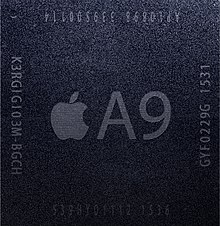Apple A9

Apple A9 processor
|
|
| Produced | From September 9, 2015 to Present |
|---|---|
| Designed by | Apple Inc. |
| Common manufacturer(s) | |
| Max. CPU clock rate | 1.85 GHz (iPhone 6s, iPhone 6s Plus, iPhone SE) |
| Min. feature size | 16 nm (TSMC) to 14 nm (Samsung) |
| Instruction set | A64, A32, T32 |
| Microarchitecture | TwisterARMv8-A-compatible |
| Product code | APL0898, APL1022 |
| Cores | 2 |
| L1 cache | Per core: 64 KB instruction + 64 KB data |
| L2 cache | 3 MB shared |
| L3 cache | 4 MB shared |
| Predecessor | Apple A8 |
| Successor | Apple A10 Fusion |
| GPU | PowerVR Series 7XT GT7600 (six-core) |
| Application | Mobile |
| Variant | Apple A9X |
The Apple A9 is a 64-bit system-on-chip (SoC), designed by Apple Inc. Manufactured for Apple by both Samsung and TSMC, it first appeared in the iPhone 6S and 6S Plus which were introduced on September 9, 2015. Apple stated that it had 70% more CPU performance and 90% more graphics performance compared to its predecessor, the Apple A8, and was one of the most powerful and energy-efficient mobile chips on the market then along with the Samsung Exynos 8890 and Qualcomm Snapdragon 820.
The A9 features an Apple-designed 64-bit 1.85 GHz ARMv8-A dual-core CPU called Twister. The A9 in the iPhone 6S has 2 GB of LPDDR4 RAM included in the package. The A9 has a per-core L1 cache of 64 KB for data and 64 KB for instructions, an L2 cache of 3 MB shared by both CPU cores, and a 4 MB L3 cache that services the entire SoC and acts as a victim cache.
The A9 includes a new image processor, a feature originally introduced in the A5 and last updated in the A7, with better temporal and spatial noise reduction as well as improved local tone mapping. The A9 directly integrates an embedded M9 motion coprocessor, a feature originally introduced with the A7 as a separate chip. In addition to servicing the accelerometer, gyroscope, compass, and barometer, the M9 coprocessor can recognize Siri voice commands.
The A9 features a custom storage solution, which uses an Apple-designed NVMe-based controller that communicates over a PCIe connection. The iPhone 6s' NAND design is more akin to a PC-class SSD than embedded flash memory common on mobile devices. This gives the phone a significant storage performance advantage over competitors which often use eMMC or UFS to connect to their flash memory.
...
Wikipedia
